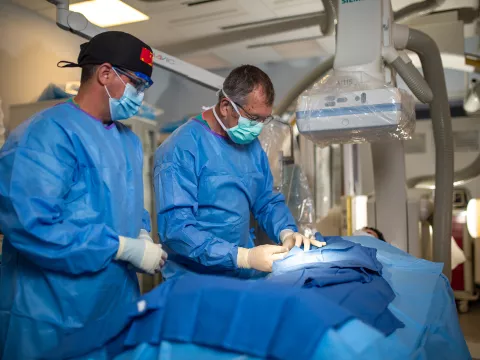
Experienced Care for Fistula
When you’re diagnosed with an arteriovenous fistula, you likely feel a lot of things. Worry. Uncertainty. A loss of control. We know what it’s like to wonder how to manage a condition you know little or nothing about — and that’s why our trusted experts have dedicated their lives to finding and developing successful treatments for you.
You and your family can turn to our experienced team that treats the different types of arteriovenous fistula with your whole-person health in mind. From diagnosis to treatment and through your recovery, we’ll support your healing in as many ways as we can.
What to Know About Arteriovenous Fistula
- What Is Arteriovenous Fistula?
-
Blood travels throughout your body inside two types of blood vessels: your arteries and your veins. Arteries carry blood that’s high in oxygen away from your heart, and veins bring this blood back once it has fed oxygen to your body tissue.
These blood vessels ensure your body gets all the nutrients and oxygen from healthy blood it needs. But sometimes, a blood vessel and a vein can form an abnormal connection called an arteriovenous fistula, or AFV, that interferes with normal blood flow and keeps those nutrients from reaching your tissue.
Arteriovenous fistulas develop in the areas covering your brain and spinal cord but can occur anywhere in your body. Some cause minimal distress, like swelling or pulsating in the affected area. Others can lead to numbness, weakness or serious arteriovenous fistula complications, like ruptures in the brain.
- Are There Different Types of Arteriovenous Fistula?
-
Because your blood vessels flow throughout your body, there are many places an abnormal connection can form, meaning there are several types of arteriovenous fistulas.
Two common nervous system arteriovenous fistulas are:
Arteriovenous Malformation
An arteriovenous malformation is similar to an arteriovenous fistula but develops within the brain and spinal cord tissue itself. Learn more about this specific condition.
Dural Arteriovenous Fistula (dAVF)
Near the brain, arteriovenous fistula can develop around the dura mater, a protective layer that surrounds your brain’s cushioning and carries blood from your brain to your heart. Dural arteriovenous fistulas usually develop later in life, though they can still affect the youngest of patients and can lead to serious complications like, heart failure, learning disabilities, and problems with speech and memory. Hearing issues, vision problems and eye bulging or swelling are all dural arteriovenous fistula symptoms.
- What Causes Arteriovenous Fistula?
-
Arteriovenous fistulas are caused by either genetics — though they are rarely passed from parent to child — or tissue separation:
- Genetics: Some babies are born with a condition that causes blood vessels to develop abnormally, like Osler-Weber-Rendu disease
- Tissue separation: Certain injuries — like stabbings, gunshots or damage that results from a complication from a procedure like cardiac catheterization — can cause tissue separation
- What Are the Symptoms of Arteriovenous Fistula?
-
The smaller your arteriovenous fistula is, the less likely you are to notice it. For large arteriovenous fistulas, symptoms can include:
- Blood pressure decrease
- Fatigue
- Heart failure
- Purplish veins that bulge through your skin
- Reddish swelling you can see on your skin
- Swelling in arms or legs
- How Is Arteriovenous Fistula Diagnosed?
-
An initial assessment of arteriovenous fistula is simple and non-invasive and usually involves your primary care physician using a stethoscope to listen for a murmur or humming in the suspected area. To confirm the presence of an arteriovenous fistula, your physician may recommend further testing, including:
Computerized Tomography (CT) Angiogram
To see if blood is circulating as it should, your physician may inject a contrast dye into your blood vessels and scan your body with a device that captures radiographic images. These images can show your doctor whether your blood vessels are flowing smoothly or if they are impacted by an arteriovenous fistula.
Duplex Ultrasound
In this pain-free, non-invasive procedure, high-frequency sound waves are used to measure how quickly your blood is flowing. These scans are the most common way to test for arteriovenous fistula.
Magnetic Resonance Angiography (MRA)
Your physician will inject contrast dye and then use energy and radio waves to capture images of how the dye is flowing.
- How Is Arteriovenous Fistula Treated?
-
Arteriovenous fistulas that are small and pose little threat are usually monitored closely by your doctor, and they may close on their own. Large arteriovenous fistula may require more hands-on intervention like:
Minimally Invasive Catheter Embolization
Also known as endovascular embolization, arteriovenous fistula embolization allows your surgeon to reroute or reduce the blood flow to the arteriovenous fistula by inserting a thin, hollow tube called a catheter into a blood vessel and guiding it toward the arteriovenous fistula. Guided by X-ray or other imaging techniques, your physician can then close the arteriovenous fistula by injecting liquid glue or a coil stent into the catheter, sealing the abnormal connection.
Surgery
Usually a last resort, your physician may recommend an invasive procedure, which varies based on the size and location of your arteriovenous fistula. In most surgeries done to correct an arteriovenous fistula, a specialized tool is entered into your skull through a small incision to treat the arteriovenous fistula directly, often closing it with a clip.

At Your Side for Every Step
Partners help us through uncertain times. Your care team will guide you through yours. We intend to make your experience as smooth as can be, which is why your care team will help you understand your plan, manage your appointments, connect you with medical finance experts and more.

